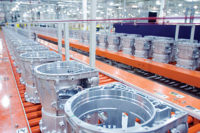Customer-centered Focus Results in Integrated Innovations
CMM manufactures study customers to enhance user experience.

Integrated innovations through a customer-centered perspective describe the newest features in Coordinating Measuring Machines (CMMs). A CMM is a measuring device tabulating the physical and geometrical traits of an object, typically a part. Manufactures of these machines are studying customers’ needs and how they use these machines. As a result, CMM manufacturers are developing more customer focused products, which remove the obstacles and make the product easier to use. To enhance the user experience, these machines are becoming more compact, flexible, portable and time saving.
Many CMMs have a bridge construction. Even though the machine may be placed under an overhead light on the shop floor, the horizontal construction of the bridge can obscure the light and reduce the illumination shined on the part. “We would laugh seeing people holding flashlights in their teeth as they are trying to set up a part,” said Milan Kocic, product manager software, sensors and user experience at Hexagon Metrology.
Integrated Lighting
As a result, one of the first CMMs integrated with work space lighting was born. CMM manufacturers are now integrating a strip of LED lights on both sides of the y-axis (vertical) and the lights turn on when the machine is turned on. “It addresses how the customer uses this piece of equipment,” said Kocic. “It allows them to remove a particular obstacle and make it a better user experience for them.”
CMM Allows for Multi-tasking
These CMMs give the users freedom to do other things during the measuring process. Gone are the days when the operator had to stay with the machine. Integrated status lighting allows the operator to walk away from the machine and with just a glance, know what phase the machine is in by the color of the lights. The light indicators represent if the machine is still operating, if the process is finished, or if the machine needs emergency attention. “Although status lights have been applied to other CMMs, it has been mostly as an external device,” said Kocic. “This is one of the first machines where it is integrated in the machine itself.”
Compact, Flexible and Portable
Compact, flexible and portable are features requested by many of today’s CMM customers. The footprint of CMMs has become smaller. A compact CMM was recently showcased at Quality Expo in Chicago. It has an active scanning head where the swivel joint allow the head to index in 15-degree increments. This allows the stylus to always point at the part. This machine has a measuring volume of 500 x 500 x 500. It is used in many applications that require tight tolerances, such as the medical and aerospace industries.
Other measuring products have reduced their footprint nearly a third. These measuring systems are manually operated shop floor machines in both the column and the radial motion. “This is a unique radial motion that reduces the footprint by almost 30% with it mounted to the rear of the base unit,” said Michael Kambeitz, product specialist for the Surface and Form Group at Carl Zeiss Industrial Metrology.
A smaller footprint allows greater portability. Some of the newest shop-floor CMMs are small enough to fit through a standard doorway in the United States. “This machine is intended to be moved,” said Eric Bennett, product manager at Hexagon Metrology Inc., “It can be plugged in any 110/220 outlet.” The machine is built on rollers. The metal bearings allow for it to be moved from one environment to another. Once the machine is moved, it can be manually leveled without the need to be recalibrated. According to Bennett, CMMs with air bearing do not have this flexibility and must be in environments with plumbed or compressed air. This machine can be used on the shop floor, as well as non-traditional places such as an office or a quasi-lab. It also is flexible in terms of the type of probes that can be put on it. This ranges from simple non-indexing touch figure probes to scanning probes, which gather hundreds to thousands of points on a part and computer.
Inspection on the Shop Floor
The portability of the machine allows for inspection on the shop floor. Inspection at the point of production avoids parts stacking up and lingering in the quality department waiting to be measured. “As production picked up and quality became more important, manufacturing tolerances became smaller and smaller,” said Bennett. “The quality department became the bottle neck of the manufacturing process.” With shop floor inspections, there are more in-process checks so there is not the wait until the very end of the manufacturing process to find out there is a bad part. “If you measure in process, in some cases you can actually salvage a bad part before it has gone to the next phase,” said Bennett.
Easy to Use
CMMs are being made to operator with little training and technical background in metrology. According to Bennett, there are two general CMM users. There are the programmers of the machines who are very skilled in writing sophisticated programming and well versed in metrology. There are also the operators on the shop floor, who just want to measure a part and do not want to have to go to the lab and have a quality person take the measurements.
Easier Set-up
Most machines come with bolt patterns sitting on the granite. In the past, a plate was put on the machine and bolted down or secured in some way. Customers were concerned how to get fixture plates on the machine. New CMM developments include a bolt pattern with kinematic seats that sit into receivers where the plate can screw in the kinematic receivers. This fixture system does not have to be used. “The plates can be laid on top of these points,” said Bennett. “This allows for multiple or a single large fixture plate depending on the strategy.” Measuring multiple parts at once and the ease of changing parts in and out is a time savings measure. According to Bennett, the measuring surface allows for most manufactured parts.
“These may seem like simple type of tasks,” said Kocic. “They make a big difference to our customers. Customers want equipment that reflects their needs and make their job easier.”
What CMM manufacturers have learned by studying users is that people want machines that are easy to use, have a smaller footprint, and portable without being disassembled. Customers also want machines that are flexible enough to measure most manufacturer parts and to use a range of probes and styli.
Looking for a reprint of this article?
From high-res PDFs to custom plaques, order your copy today!




